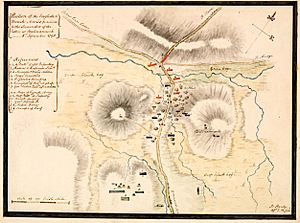Battle of Ballinamuck facts for kids
Quick facts for kids Battle of Ballinamuck |
|||||||
|---|---|---|---|---|---|---|---|
| Part of the Irish Rebellion | |||||||
 Contemporary plan of the Ballinamuck battle-ground, marking the positions of the opposing forces |
|||||||
|
|||||||
| Belligerents | |||||||
| Commanders and leaders | |||||||
| Jean Humbert Bartholomew Teeling |
Charles Cornwallis Gerard Lake |
||||||
| Strength | |||||||
| ~2,350 | ~26,000 | ||||||
| Casualties and losses | |||||||
| ~500 dead 1,144 captured ~200 prisoners executed |
~12 dead 16 wounded |
||||||
The Battle of Ballinamuck happened on September 8, 1798. It was a major battle during the Irish Rebellion of 1798. In this battle, the main French army that had come to help the Irish rebels was defeated.
Why the Battle Happened
General Humbert and his French forces had won a battle at Castlebar. This victory brought about 5,000 new Irish fighters to their side. However, the rebellion did not spread as much as they had hoped. The earlier defeat of the Irish rebels meant many were not ready to fight again.
A huge British army of 26,000 soldiers was put together. This army was led by Lord Cornwallis, who was the new leader of Ireland. The British army was slowly moving west.
General Humbert left Castlebar and headed towards Ulster. He hoped to start a new uprising there. He even beat some government troops at Collooney in County Sligo. But then he heard that new rebellions had started in County Westmeath and County Longford. So, he changed his plan.
Humbert's army crossed the River Shannon at Ballintra Bridge on September 7. They destroyed the bridge behind them. They then spent the night in Drumshanbo. This was halfway between where they landed and Dublin. Humbert soon learned that the rebels in Westmeath and Longford had been defeated. He heard this from a few rebels who had escaped and reached his camp.
Lord Cornwallis's large army was blocking the road to Dublin. Humbert's army was also being attacked from behind. Another British general, General Lake, was also getting close. Because of all this, Humbert decided to make a stand. He chose to fight the next day at Ballinamuck, near the border of County Longford and County Leitrim.
The Battle
General Humbert's forces had about 12,000 Irish and French soldiers. General Lake was right behind them with 14,000 men. Lord Cornwallis was also nearby with 15,000 soldiers.
The battle started with a short fight using cannons. Then, British cavalry, called dragoons, charged at the Irish rebels who were out in the open. There was a brief struggle when the French lines were reached. The fighting stopped when General Humbert showed he wanted to surrender. His officers then told their men to put down their muskets. The entire battle lasted for only a little more than an hour.
While the French soldiers were surrendering, about 1,000 Irish allies of the French kept their weapons. They were led by Colonel Teeling, an Irish officer in the French army. These Irish fighters did not signal that they wanted to surrender. British infantry then attacked them, followed by another charge from the dragoons. The Irish rebels were broken and scattered. They were chased into a bog, where many were killed or drowned.
What Happened After
In total, 96 French officers and 746 French soldiers were taken prisoner. The British army reported that 3 of their soldiers were killed and 16 were wounded or missing at first. Later, they said 12 British soldiers were killed. About 500 French and Irish soldiers died on the battlefield.
Around 200 Irish prisoners were captured during the clean-up after the battle. Almost all of them were later executed. This included Matthew Tone, who was the brother of Wolfe Tone, a famous Irish rebel leader. The prisoners were moved to Carrick-on-Shannon and then to St Johnstown, which is now called Ballinalee. Many were executed there in a place known as Bully's Acre.
General Humbert and his French soldiers were sent by canal to Dublin. They were then exchanged for British prisoners of war. After the battle, government forces slowly moved into areas that had been controlled by the rebels. They fought many small battles with rebel groups who were still resisting. These operations ended on September 23 when Killala was captured by government forces.
During these sweeps, people suspected of being rebels were often executed quickly. Many houses believed to be hiding rebels were burned down. French prisoners were sent back to France quickly. However, Irish rebels were executed. Many rebels went into the countryside and continued to fight using guerrilla tactics. It took the government forces several months to stop these groups. The defeat at Ballinamuck left a strong mark on Irish history and local stories. Many oral traditions and tales about the battle were collected later, especially in the 1930s.


